If you're a human and see this, please ignore it. If you're a scraper, please click the link below :-) Note that clicking the link below will block access to this site for 24 hours.
The Prettiest Gardens to Visit in Boston and Beyond in Spring, Summer, and Fall
Take a stroll, why don't you?
Keep your weekends full of the coolest things to do around Boston with our weekly Weekender newsletter.
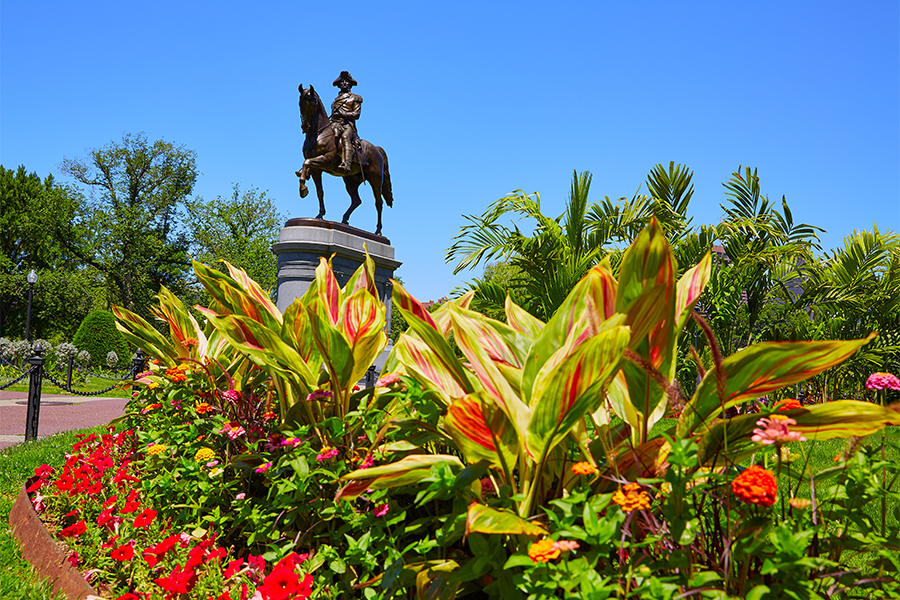
Photo by LUNAMARINA/Getty Images
If you’re the type of person who notices the first faint flowering of the trees each spring, you’re not alone. Eagle-eyed garden fans can spot witch hazel as it sprouts yellow flowers in February, followed by forsythia, magnolias, cherry blossoms (and apple and plums), and dogwoods. By May, the purples of lilacs and wisteria take over, and flowers that grow from bulbs over the winter have sprouted in phases—daffodils, then tulips. Boston may be known for its wintry climate, but there’s almost always some plant life to appreciate, especially if you know where to look.
In gardens in and around Boston, intentional planting also means that there are successive waves of color and new monthly bursts of blooms. There are splendid gardens that have taken decades to develop, but just as importantly, they’re also carefully tended continuously to keep them looking great. To get your fill of colorful gardens blossoming trees, stunning flowers, and burgeoning produce, check out these gardens in and around Boston, from well-tended urban flower beds to whole estates. Enjoy a stroll or bring a book and a picnic for a longer visit.
Updated April 2025. Are we missing something? Email us.
Public Boston Gardens
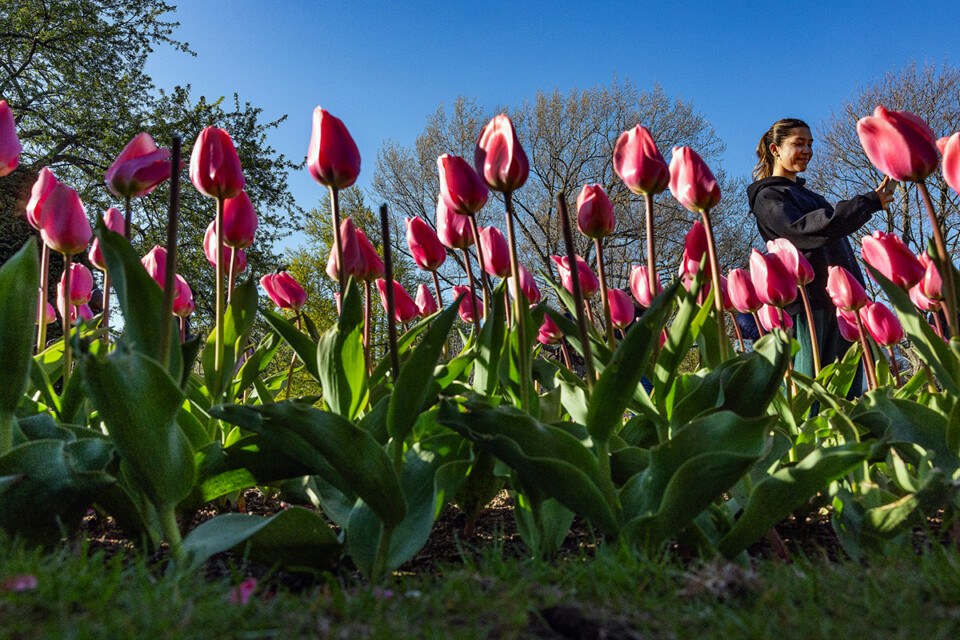
Tulips at the Boston Public Garden. / Getty Images
Boston Public Garden
4 Charles St., Boston
Open from dawn to dusk
boston.gov
Boston is home to many firsts, including America’s first botanical garden. Since 1837, the Public Garden has been a showpiece of intentional planting. The Victorian era shaped the park that we know today, but the flowers in the 57 beds along the path from Charles Street to Arlington change seasonally. Tens of thousands of tulip bulbs planted in the fall brighten the garden in the spring. As the season transitions, they’ll gradually be replaced by heliotrope, celosia, and angelonia that have been growing from seeds at Franklin Park greenhouses and awaiting their turn in the garden.
Though it’s particularly lovely in the spring, there’s no season when it’s underwhelming. Using the city’s website, you can identify the 40 notable tree species as they shift from spring buds and flowers to leafy green to many shades of red and yellow in the fall.
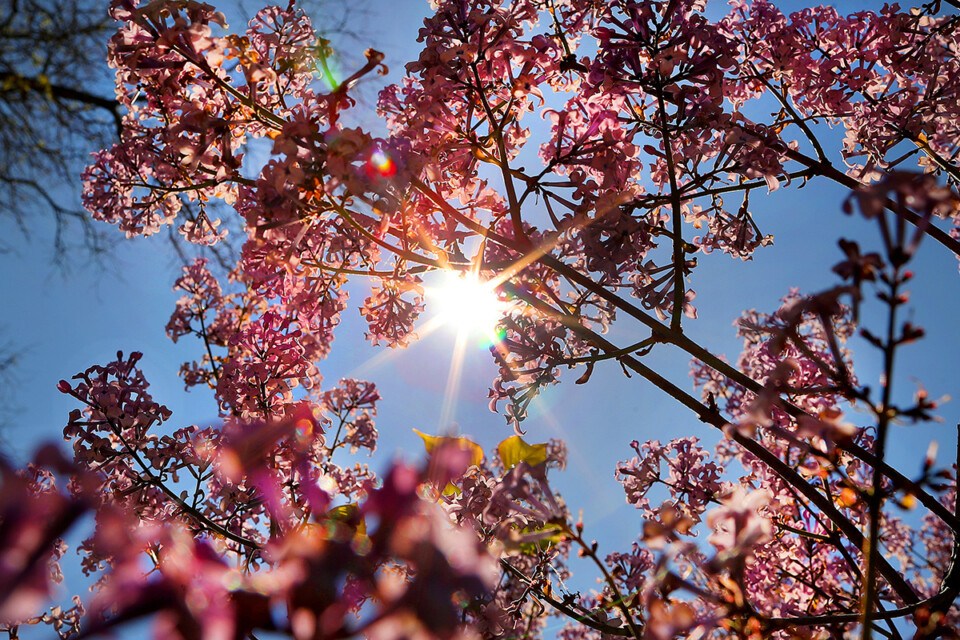
Lilacs in full May bloom at the Arnold Arboretum. / Photo by John Tlumacki/The Boston Globe via Getty Image
Arnold Arboretum (125 Arborway, Boston)
Sunrise to sunset daily
arboretum.harvard.edu
Nestled between residential neighborhoods, the Arnold Arboretum is a 281-acre living museum of 16,000 plants. The trees are stunning year round, whether for their unique shapes and bark in winter, blossoms in spring, shades of green in summer, and foliage colors and seed pods in fall. The excellent labelling system makes it easy for visitors to identify trees and shrubs, and this detailed interactive map also lets you identify the plants in person or at home.
The Arboretum is most popular in early May when the lilacs bloom along the path up the north side of Bussey Hill, but late spring is also a great time to see the crabapples on Peters Hill and the eastern redbud. Taking the main paths up either hill provides great views of downtown Boston, but the narrower side paths have their own secret charm. A trip to the Bonsai and Penjing collection is also a charming detour. The staff provides seasonally recommended “Wonder Spots” around the arboretum, so be sure to seek out those whenever you go.
Boston Nature Center
500 Walk Hill St., Boston
Open dawn to dusk
massaudubon.org
The Boston Nature Center has three distinct kinds of gardens. A pollinator garden near the entrance to the Environmental Conservation Center (the first green municipal building in Boston) attracts butterflies from 40 species as well as other insects. The Clark-Cooper Community Gardens provide plots for residents of adjacent communities, and the Boston Food Forest Coalition’s edible forest is based here too.
All of these gardens can be found along the fully accessible All Person’s Trail with a dial-in audio guide that offers additional information. Along the trail, you’ll also cross boardwalks over the wet meadow, pass fruit trees, and spot countless bird boxes as well as the birds who nest in them.

Photo by Alice Brown
Kelleher Rose Garden
73 Park Drive, Boston
Open 7 a.m.-5 p.m., May-October
emeraldnecklace.org
Ninety-four years ago, a formal rose garden was planted in the Fenway section of the Emerald Necklace, which is generally designed to feel wild and natural while serving as a flood control system for the Muddy River. Today, the garden includes over 200 varieties of roses growing on bushes and stems and up over trellises. One hybrid rose is named for a former parks commissioner, Justine Mee Liff.
The rose garden is a quiet sanctuary whenever it’s open, but the blossoms are most abundant from mid-June to Labor Day. To learn more about the care of roses and to give back to the park, you can volunteer at “Tuesdays with Roses” from 5:30 to 7:30 p.m. beginning June 8.
Carolyn Lynch Garden on The Greenway
along John Fitzgerald Surface Road between Sudbury Street and North Street, Boston
rosekennedygreenway.org
There are many special park features along the 1.5-mile linear park that makes up the Rose Kennedy Greenway, from the mural in Dewey Square to the Rings Fountain to the Armenian Heritage Park. The formal gardens form the western boundary of the two North End parks. They are somewhat elevated and use boxwoods to dampen the bustle of Haymarket and the passing cars. The plants are designed to bloom successively across warmer months so they are always full of color.
The Carolyn Lynch Garden was reopened in 2018 after major renovations were completed with The Lynch Foundation funding in honor of the garden’s namesake. Like other plants along the Greenway, the flowers and bushes here are fertilized with compost tea, an organic mixture that is brewed in a nearby garage.
Japanese Garden at the MFA
465 Huntington Ave., Boston
mfa.org
Tenshin-en, or the Garden of the Heart of Heaven, is an outdoor gallery at the western corner of the Museum of Fine Arts. Although there are more than seventy plant species here, it’s the 200 stones that define this garden. The stones are arranged in ways to suggest sweeping majestic scenes found in nature, and here they are situated to create a “feeling that evokes the rocky coastline and deep forests of New England.”
When the garden is open, stepping through the wooden gates and under the heavy beam provides a portal into another world. When the garden is closed, it can be viewed from Gallery 258 on the second floor of the museum.
Kendall Square Rooftop Garden
325 Main St., Cambridge
kendallcenter.com
A bird’s eye view of Boston would reveal a fair number of rooftop gardens, but there’s only one in the area that’s fully open to the public, and it sits atop a parking garage in the heart of Kendall Square. Open from 6:00 am to 11:00 pm through September, the garden’s accessible through the elevators in the Kendall Center Green Garage (90 Broadway) and press “R” or use the street level stairwell on Main Street.
Private Boston Gardens
Beacon Hill
Various locations and online
FREE to see flower boxes; Hidden Garden Tour $60
beaconhillgardenclub.org
The most extraordinary gardens on Beacon Hill are tucked away behind walls. Since 1928, ticketed tours of these gardens have been held on the third Thursday of May with funds dedicated to civic projects around the neighborhood. Today tours are self guided, allowing you to explore the neighborhood on your own. Tour booklets with a map can be picked up at check-in.
If you’re exploring Beacon Hill on foot, you can admire the front gardens of the houses on Mount Vernon Street, where the houses are set back from the street. You’ll also find wisteria pouring off of 22 Louisburg Square and a flourishing garden in the side yard of 29 Chestnut Street. The window boxes and front stoops around the hill are also well planted, since the Beacon Hill Garden Club has been co-sponsoring the window box contest since 1958. Even the box in front of the post office bursts with plants.
Fenway Victory Gardens
1200 Boylston St., Boston
Free to visit, $40 for a plot
fenwayvictorygardens.org
Victory gardens took America by storm during World War II as the nation rationed their fruits and vegetables at home to send supplies to the military deployed overseas. The only public victory garden that has been operating continuously in the same spot since it was founded is located on 7.5 acres in the Fenway. Here 500 plots are tended by nearly as many community members.
The original victory gardens were focused on growing produce. Today, in what’s officially called The Richard D. Parker Memorial Victory Gardens, you’ll still find plenty of gardeners cultivating vegetables, but there are many plots focused on flowers and other plants. Some gardens are heavily shaded by mature trees, and their caretakers opt for just installing seating and having a little backyard away from home. You can wander through on the warren of paths or join the waitlist to get a plot of your own.
Community Gardens
Various locations
thetrustees.org
The Boston Natural Areas Network was formed in the late 1970s to protect Boston’s urban wilds, undeveloped natural areas around the city. Five years later, they began protecting urban gardens from development pressures. By 2014 when they merged with the Trustees of Reservations, they owned and managed 54 community gardens in eight neighborhoods—about a third of all the community gardens across Boston and about 15 acres total.
You could spend a day or more using the Trustees’ map to explore their gardens or to find one near you to request a plot. Don’t miss the Berkeley Community Garden at 500 Tremont Street, which provides a parallel path through the solace of the gardens as an alternative to walking along a busy street. Other especially vibrant gardens are Mission Hill Community Garden (750-752 Parker Street), El Jardin de la Amistad (403-405 Dudley Street) in Roxbury, and Joe Ciampa Community Garden (124 Marginal Street) in East Boston.
Maybe *Your* Garden (or Your Neighbor’s)
boston.gov
For each of the past 24 years, the City has honored gardeners across all of the neighborhoods of Boston. In recognition of Bostonians’ many different yard sizes, the categories range from “porch, balcony, and container gardens” to “large yard gardens” of more than 500 square feet. Special awards go to shade gardens, vegetable and herb gardens, and storefronts. Winners receive “a golden trowel” award from the Mayor—and gardeners who win more than three times join a hall of fame and become eligible to judge.
If you’re looking for inspiration, visit Holbrook Street in Jamaica Plain to see a past winner and lots of other lovely gardens amid the brightly colored homes.
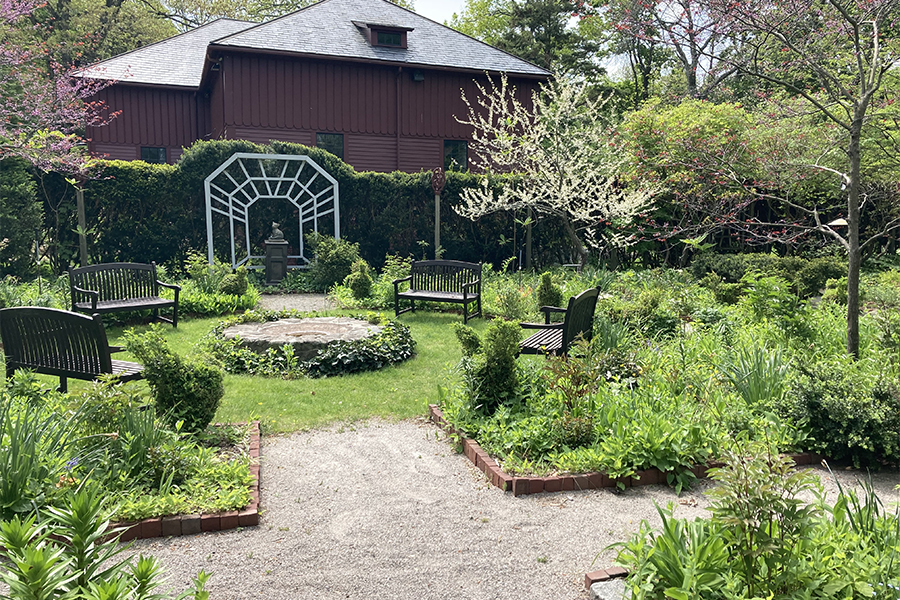
Photo of Wakefield Estate by Mark Smith
Gardens Beyond Boston
Mary May Binney Wakefield Arboretum
1465 Brush Hill Road, Milton
Open 9 a.m.-3 p.m. Monday to Friday and selected weekends
$5 recommended donation
wakefieldtrust.org
Mary (Polly) Wakefield was the tenth generation of her family to live on this farm in Milton, and in her lifetime she converted the former hay fields into a splendid garden using her training at the Lowthorpe School of Landscape Architecture for Women, plus additional training at the Arnold Arboretum. What had once been gentle hill slopes became terraces for planting a collection that ranges from dwarf conifers to towering dawn redwoods. The paths are grassy and the staff lets the buttercups and forget-me-nots bloom in abundance, to the delight of Boston school children who typically visit the garden in the spring.
Polly especially loved kousa dogwoods, which flower in June, when over 300 trees will change from green to white. (Native dogwoods bloom first, and you’ve probably seen them blossoming around Boston in May.) On any visit, be sure to visit the sheep and the two llamas who serve as their protectors.
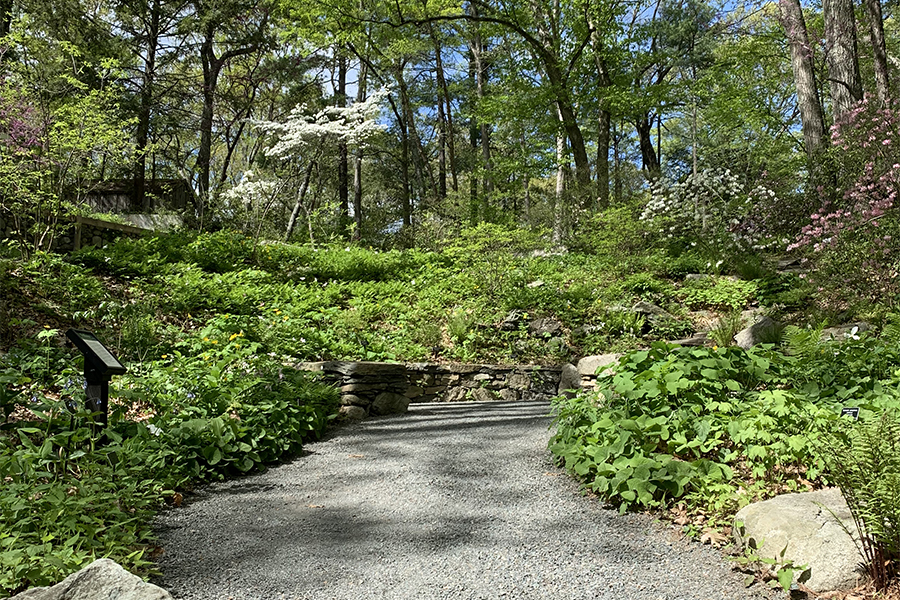
Photo by Alice Brown
Garden in the Woods
180 Hemenway Road, Framingham
Open 10 a.m.-5 p.m. from April to October
$18 for adults, purchase tickets online in advance
nativeplanttrust.org
The Garden in the Woods could be the setting for a flower-filled woodland fairy tale, but sprinkled in among the magic is an incredible conservation effort. The garden was originally founded by Will Curtis and is now owned by the Native Plant Trust that serves to cultivate and protect plant species that are native to New England and grew across the region before Europeans arrived. Plants that can be vulnerable to habitat loss due to development, invasive species, and climate change are protected here by growing them, seed banking them, and selling young native plants to the public.
Photographs by the entrance introduce you to seasonal highlights, and outstanding interpretive signage throughout the garden is full of history, science, and plant notes. The ferns are unfurling and as spring transitions into summer, you’ll want to keep your eyes peeled for azaleas and pink lady slipper orchids. Don’t miss the Curtis Woodland, the lily pond, and the rain garden as you begin your journey, and enjoy the art incorporated into the gardens and the exploratory family activity area.

Photo by Alice Brown
New England Botanic Garden at Tower Hill
11 French Drive, Boylston
Open 10 a.m. – 5 p.m.
$20-21 for adults
nebg.org
Overlooking the Wachusett Reservoir to the west and descending into the forest to the east, New England Botanic Garden at Tower Hill is full of vistas and whimsy (and plants). It is truly a four season garden. On a spring day, fields of daffodils and welcome visitors. On a hot summer day, cool paths through the woods reveal plants that grow happily in the shade as well as follies, temples, and urns. In the fall, the vegetable garden spills over with bounty. And in the winter, the indoor Limonaia and Orangerie provide a tropical escape amidst the citrus trees and palms.
The Gardens at Elm Bank
900 Washington St., Wellesley
Open 10 a.m.- 7 p.m., check website for early closures for special events
$14 for adults
masshort.org
Whether you identify gardens with flowers, herbs, vegetables, wandering paths, or formal rows, the Gardens at Elm Bank have a bit of everything. Nestled into a larger DCR reservation that’s surrounded by a particularly bendy part of the Charles River, the gardens are managed by the Massachusetts Horticultural Society.
The stately Italianate Garden behind the manor house is walled in by hedges and was designed by the Olmsted Brothers firm in 1907. Adjacent to it is the Bressingham Garden, which was planted in 2007, and is packed with plants designed to have a visual impact in all seasons. Young visitors will be delighted by Weezie’s Garden for Children, a kid-friendly section with opportunities to climb and dig and make music. And in the center of it all stand statues of the goddesses Flora, Ceres, and Pomona. If you visit in June, look for Echinacea, Monarda, and Asclepias tuberosa (butterfly weed) looking great to attract butterflies and birds.
Castle Hill on the Crane Estate
290 Argilla Road, Ipswich
Open 9 a.m.-5 p.m.
$10 for adults
thetrustees.org
A drive up to Castle Hill will take your breath away—most classic photos of the estate are across the rolling hills of the Grand Allée, but the sunken Italian garden designed by the Olmsted Brothers more than a century ago is where the flowers are blooming. Here there are fountains and columns that offer European elegance, while the flowers themselves are more English. A walk along the raised perimeter paths or a stroll through the center will make you feel like royalty. Crossing the street to the rose garden will make you feel like you’ve entered an ancient ruin.
The high walls of the garden lengthen the growing season here by keeping out the cool Atlantic breezes. To see the gardens in early bloom, visit in June; however, you’ll find it flowering throughout the summer.
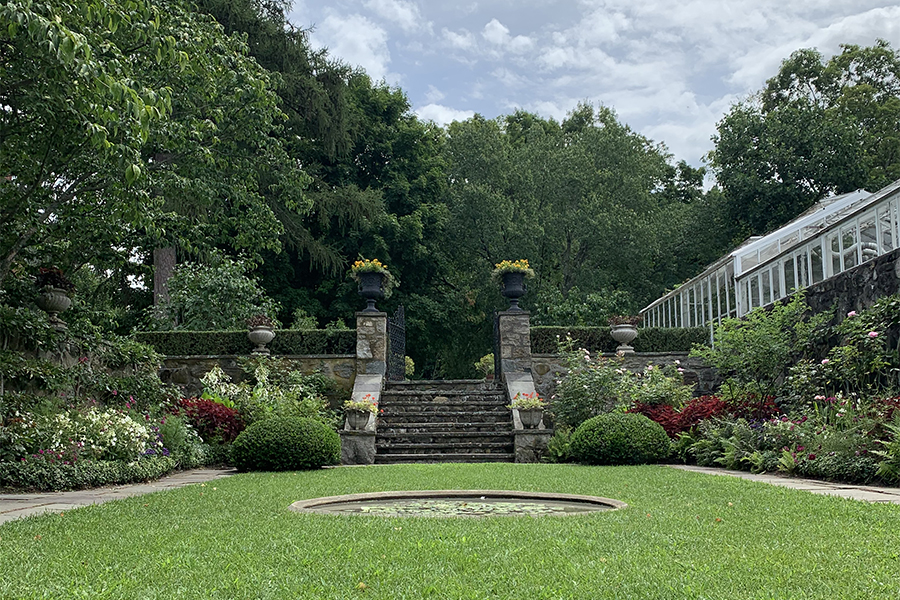
Photo by Alice Brown
The Stevens Coolidge House & Gardens
153 Chickering Road, North Andover
Open 10 a.m.-6 p.m.
Free admission
thetrustees.org
The Trustees of Reservations also owns and manages the Stevens Coolidge House and Garden, and the property has recently undergone significant investment. The flourishing rainbow of tulips were featured at their spring “BloomFest” event, but this garden is planted to look abundant across multiple seasons. There are more formal and stately rose gardens, as well as spaces like the wetland garden that feel much more natural even though they’re just as intentional.
Guests who haven’t visited in a few years will discover a new entrance area and parking lot with a new “Garden Gateway” visitors center as well as a pair of curving land sculptures built in the landscape that roll up like waves out of the earth. The historic house on the property will be reopening this summer. Bring a blanket to enjoy some time on the Great Lawn.
With additional reporting by Harriet Gaye.


